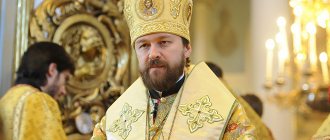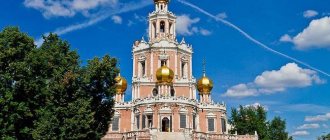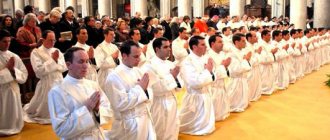| First part | Second part | Third part |
A religious agreement concluded between part of the hierarchy of the Kyiv Metropolis of the Patriarchate of Constantinople and the Apostolic Capital in Brest in 1596 created the Russian Catholic Church of the Eastern Rite. Scientific debate about the pattern of occurrence of this phenomenon has been going on for a long time. The arguments of supporters of the unification of churches in Poland extend very widely.
From the assertion that this was a breakthrough towards Christian unity, to attempts to correlate the ideology of Uniatism with the traditions of European humanism [42, p. 90, 91] and explain it by the desire of the advanced part of Russian society to solve the problem of religious, cultural and national self-determination of Russian subjects of the Polish-Lithuanian Commonwealth [43, p. 70]. As a result, one thing is clear: the historical actualization of the Uniate idea has shown its inconsistency. The ideologists and creators of Russian Greek Catholicism had high hopes for him. But the union failed to cope with any of the tasks assigned to it.
She was unable to take a worthy, stable position in society and put the Western Russian Church on an equal footing with Polish Roman Catholicism. The union did not stop the spiritual and cultural split of medieval Russian society in Belarus. On the contrary, she completed it, and in the 17th – 18th centuries. The ancestors of modern Belarusians finally lost their culture-forming elite through the union. As a result, the Old Belarusian, as they say now, language and culture of the Belarusians were artificially pushed to the very bottom of society, into the serf peasant environment, to the level of folklore. Here, of course, they could not develop normally and reach a high level, which slowed down the natural development of the Belarusian people. The union became an obstacle to achieving socio-political stability in the Polish-Lithuanian Commonwealth and strengthening its position in the international arena. Moreover, it served as one of the reasons for the death of this state. Finally, the Uniate Church failed to carry out the Catholic mission in Muscovite Russia and further in the East, which Rome very much counted on 1 . All its energy was spent on expansion within the territory of modern Ukraine and Belarus. Moreover, this expansion turned out to be associated with such excesses that alienated the Orthodox Russians even more from Catholicism and strengthened among them suspicion and hostility towards Rome. The history of the union is replete with dramatic and very instructive moments for modern church and political leaders. One of its most interesting periods is the end of the 18th and the first third of the 19th centuries. At this time, the Uniate church community, as a result of the death of Poland, found itself divided between the Russian and Austro-Hungarian empires. Of particular interest here is the tragic fate of the Russian part of the union, reunited with Orthodoxy at the Polotsk Cathedral in 1839. The study of the Uniate Church within Russia at the end of the 18th and beginning of the 19th centuries. attracted many historians. Research of this phenomenon from the Russian historical school belongs to M.O. Koyalovich, G.Ya. Kiprianovich, A. Yurashkevich, Yu.F. Krachkovsky, I. Chistovich, E. Orlovsky, P.O. Bobrovsky, I. Shabatin and others. Among Polish authors it is necessary to name the serious works of E. Likowski, Z. Dobrzynsky, M. Radwan. Of the Belarusian historians, Archbishop A. Martos, S.V. drew attention to Uniate issues during this period. Morozava, E. Filatova, M. Nosko. A common characteristic of all studies of the Uniate topic is a high-quality study of the source base and, at the same time, a directly opposite interpretation of the same facts and documents, which is determined by the religious and cultural tastes of the authors. In addition, the lack of reflection of the Russian Uniates themselves, reunited with Orthodoxy in 1839, has led to the fact that all historians have studied and are studying the union as external researchers dissecting a dead body. The confessional and cultural alienation of the authors from the phenomenon being studied, the fact of the death of the union weighing heavily on historians, result in the fact that Russian Greek Catholicism is studied as religious in a broad sense, cultural, political, etc. phenomenon. At the same time, historical science did not show sufficient attention to the analysis of the problems and prospects of the Uniate Church in Russia in the first third of the 19th century, i.e. immediately before the start of preparations for its liquidation. In its pure form, this problem, despite all its obvious significance, was not raised by anyone. It seems that the conclusions of such an analysis can significantly affect assessments of the events and roles of historical figures associated with the destruction of the union in the Russian Empire. The chronological framework of the study covers a period of 25 years from 1803 to 1828. The lower limit is 1803 - the time of the beginning of the relative stabilization of the internal and external position of the Greek Catholic Church after the upheavals that befell it at the turn of the 18th and 19th centuries. The upper limit - 1828 - is associated with the beginning of reforms in the union, which had the specific goal of its liquidation. Around 1772, the Catholic Church of the Eastern Rite in the Polish-Lithuanian Commonwealth numbered 9,452 parishes [1, s. 21], distributed among 8 dioceses. As a result of the 3 partitions of Poland 1772-1795. about 60% of Uniate parishes (from 5600 to 6052, the exact number is unknown [1, p. 23]) ended up within the Russian Empire. The number of Uniates who became Russian subjects is difficult to determine, but based on a comparison of data collected by various historians, it probably ranged from 5 to 6 million people. In the new socio-political conditions, when the union lost the support of the Polish Catholic authorities, and Orthodoxy, on the contrary, acquired state patronage, the Greek Catholic Church became defenseless in the face of external influences. Now the question of her continued existence was closely connected with her internal forces. Events of the late XVIII - early XIX centuries. showed that the positions won by the union in the Polish-Lithuanian Commonwealth were very weak. Over the three decades from 1772 to 1803, millions of believers and thousands of clergy left the union in favor of both Orthodoxy and pure Catholicism 2 . As a result, by 1807 this church within the Russian Empire was a relatively small community. It numbered from 1425599 [1, s. 68] up to 1,538,890 believers [1, s. 70]. The number of parishes reached 1436, since 1809 distributed among 4 dioceses. The clergy consisted of 1,735 parish and 738 non-parochial priests. Uniate monasticism, united by the charter of St. Basil the Great and hence the name of the Basilian Order (otherwise Basilian), was organized on the model of Catholic monastic orders and divided into three provinces: Lithuanian, Belarusian and Russian. In 1801, the order in Russia consisted of 722 members and had 85 monasteries [1, s. 76]. The Uniates lived compactly in the North and North-West of Belarus within the modern Grodno, Vitebsk, and parts of the Brest and Minsk regions. In the Ukrainian territories, where by 1803 there were 176 parishes, 195 parish priests and 94,977 believers left in the union [1, s. 29, 72], they lived in small isolated groups scattered over vast areas. Ukrainian Uniates made up a small part of the total number of Russian Greek Catholics. Therefore, the main events that influenced the fate of the union in Russia took place in the Belarusian lands. During the period described, the Uniate Church retained the metropolitan structure and a solid episcopal structure [1, s. 36]. The highest administrative ecclesiastical administration of the Eastern Rite Catholics was united with the highest administration of the Latin Church. Since 1805, it was concentrated in the 2nd department of the Roman Catholic Ecclesiastical College, where since 1806 the Uniate Metropolitan presided. By the 18th century, the union had lost its autonomy, which was initially declared. Therefore, the rightful head of this church at the beginning of the 19th century. was no longer a metropolitan, but the Pope himself. The metropolitan's competence remained quite broad, but in general he was relegated to the position of only the eldest among the bishops. In 1801, the Russian government restored the independence of the management of the Basilians from the Uniate hierarchy, which had existed until 1795. As a result, the leadership of Uniate monasticism could pursue its own church-political course, which introduced a large share of uncertainty into the system of higher management of the Union. This reduced the manageability of the church, caused chaos in office work and delays in the implementation of necessary activities. There was no uniformity at the level of diocesan administrations in the union. By analogy with the Catholic Church of the Latin rite, in the Greek Catholic dioceses there was an institution of diocesan chapters. They played the role of advisory bodies, overseeing the life of the church and executive governing bodies, designed to help the bishops. The chapters in the union were not a mandatory and equally structured institution. They existed in the Brest, Polotsk and Lutsk dioceses and differed significantly in their internal structure, the fullness of delegated powers and means of maintenance. The Brest Chapter stood out with the strongest organization and authority of its members, which, due to these circumstances, played a large role in the union. A chapter was never created in Vilna. The burden of administrative work here lay on the consistory, and the responsibility of assisting the bishop in matters of direct administration was carried out by a representative of the Brest Chapter. In the sphere of canon law, chaos reigned in the Uniate Church. Here the laws characteristic of both the Roman and Greek churches were used, which were far from meeting modern needs and often contradicted each other. I. Semashko testified in 1828: “We Uniates do not know the law of our church at all, although in the Lutsk and, as far as I know, the Polotsk consistory there is a helmsman’s book; but it lies without any use, and both in all Uniate consistories, and in the 2nd department. Collegiums are guided by various works of canon law” [2, p. 487]. This situation had a negative impact on the management of the Uniate Church and, especially, on church legal proceedings, opening up wide opportunities for abuse [2, p. 12-13]. An example of this was the process of discrediting and removing from the see of Polotsk Archbishop I. Krasovsky. In Uniate liturgical practice at the beginning of the 19th century. there was also no order. It was characterized by a syncretic combination of Orthodox and Latin rites. There were a large number of different Uniate editions of liturgical literature, in which, depending on the time of publication and the views of the authors, the ratio of Latin and Orthodox elements varied over a wide range. The priests used all this variety according to personal tastes. “Every private person among us,” wrote I. Lisovsky, addressing Rome in 1786, “adds or changes something at will; there is no rule that everyone obeys. There are so many new editions of service books, so many modifications of rituals. This even became a proverb among the people who say: “as a priest, that’s a new rite”” [3, p. LIV; Wed 4, p. 34]. This state of affairs in the union persisted until 1834, when Orthodox liturgical literature was introduced into Uniate liturgical use. In the field of spiritual education in Russian Greek Catholicism, a strange situation has developed. The Basilian monks received good training, who created for themselves a wide network of schools with high-quality primary theological education [5, p. 73-74]. In addition, they had the opportunity to send their members to Catholic educational institutions abroad. At the same time, the formation of the secular parish clergy was in a deplorable state. At the beginning of the 19th century. There were several Uniate seminaries: Lavrishevskaya, Sverzhenskaya, Zhidichenskaya and Polotsk. Neither in terms of curriculum, nor in the level of teaching, nor in the number of students and the quality of their education, they, with the exception of Polotsk, did not meet the needs of the church [5, p. 173; 6, p. 99]. The majority of the ordinary Uniate priesthood either received home education or studied in primary monastery schools or secular gymnasiums. Neither theology nor liturgics were studied there [7, p. 28]. The virtual absence of a normal system of theological training led to the fact that in the 30s of the XIX century. in the vast Belarusian diocese, among the white clergy, 81% did not have secondary education [8 p. 46]. At the same time, in 1803, a Uniate department began to operate at the Catholic Main Seminary at the University of Vilnius, which provided theological students with a high-quality higher education. Graduates of this remarkable theological school in many respects played a huge role in the fate of the union in Russia. The financial condition of the Greek Catholic Church cannot be called satisfactory. She possessed quite large fundush funds. But they were used ineffectively and were extremely unevenly distributed. Basically, finances were concentrated in the hands of the Basilians [5, p. 125-127], who disposed of them in the interests of order institutions and monasteries, but not in the interests of the entire church. As a result, the budgets of church-wide Uniate institutions were very meager, and most churches were in poor condition. Only monasticism and a narrow circle of white clergy were well-off financially: members of the corporation of the commanding clergy and seminary teachers. Very few of the parish clergy were wealthy, and in historical literature there was a strong stereotype about the extreme poverty of this clergy [7, p. 33-35; compare 11, p. 27]. Uniate priests subsisted on payment for the fulfillment of demands and church or personal land plots, in some cases with a small number of peasants. In many parishes, priests received financial assistance from local Polish landowners. It must be said that for the most part, despite the poverty of life, Uniate priests were strong masters [9, p. 181-197; 10, p. 102]. From this brief overview it is clear that the union experienced great problems in vital areas during the period described. But, of course, it was not an incurable disease. Such imbalances can be easily eliminated by reform. The hopes here were based on the fact that the Orthodox offensive and Latin proselytism dealt the Uniate Church a terrible but not fatal blow. It was not destroyed, and, moreover, the shocks it experienced cleared it of non-solid elements. All this provided Greek Catholicism with a historical chance to continue to exist. His survival depended on: 1) the loyalty of his flock; 2) the desire of the hierarchy and clergy to protect and preserve their religion. The loyalty of the flock is the foundation of the existence of any religious society. It is based on people’s firm confidence in the salvific path offered by the church of which they are members. The devotion of the flock to the Uniate Church could be based solely on the confidence of believers in the religious truth of the union. The very idea of uniting Christians of the East and West through an ecclesiastical union is a complex and discursive theological system. Its perception is directly related to a high level of knowledge of the truths of the Christian faith and church history, the breadth of theological thinking, cultural pluralism and, most importantly, with a certain special direction of theological feeling. All this cannot be accessible to the broad masses of believers, who mostly live on a minimum of religious knowledge and time-honored church tradition. Therefore, the Uniate idea belongs to a few marginalized people from spiritual life, and its propaganda in its pure form, although it is the only way to gain loyal followers, cannot have much success. The futility of the Ferraro-Florentine church agreement of 1439 in the Orthodox East is the best confirmation of this. Hence, it is far from accidental that the spread of the union in the Polish-Lithuanian Commonwealth was not associated with preaching to the people the idea of Christian unity [12, p. 210], but was of a state-legal and church-practical nature. The only thing the Uniates convinced people of was the statement made by Metropolitan I. Potey that the Western Russian Church initially had close ties with Rome and was subordinate to it after the Council of Florence. In confirmation of this, a message from Kyiv Metropolitan Misail to Pope Sixtus IV, dated 1476, was cited [13, p. 185-186; Wed 40; 41]. According to the apt remark of K.S. Serbinovich: “The Pope, in the bull given to the first Uniate bishops, explained: “Finally, 150 years (after the Council of Florence), you are returning, O Russian bishops, to the stone of faith...” and so on. Rome’s own recognition at that time that Rus' did not depend on it until 1596 is more important than all the current contrary guesses” [14, l. 7]. However, I. Potey found a simple and quite effective propaganda technique that worked well in the first decades of the union’s existence. But with the development of the Eastern Rite Church, such preaching turned against it. A great contradiction arose in the minds of believers. If the union with the Apostolic capital existed for a long time and at the same time the Western Russian church freely preserved Orthodox teaching and, most importantly for ordinary believers, Orthodox Slavic worship, then for the Uniates it would be quite logical to steadily preserve this ancient heritage of their ancestors, limiting themselves only to obedience to the Roman high priest. As a result, as Russian Greek Catholicism evolved towards Roman liturgical practice, simple Uniates - both the laity and the lower parish clergy closest to them - retained the memory of their church antiquity as a saving shrine. This closed their religious worldview from external influences and resulted in the people’s persistent desire to adhere to the remnants of the Cyril and Methodius tradition. As a result, the union, over the two centuries of its existence, has never been able to completely transform Belarusians into true Catholics. This, however, is recognized even by modern apologists of the union with reference to the classics of Marxism-Leninism. “The fact of Zahannna Pad UNIIATSKAI Abalonkai is right -handed faith,” writes S.V. Morozova, - adhesive to the F. Engelsam I Patzverjana Shmatlіkimi Krynikami ”[15, p. 84]. The statement of such a religious state of the Uniate flock does not explain the large losses of the union on the fracture of the XVIII and XIX centuries. In favor of the Latin rite, and especially the fact that many Uniates, after connecting with the Orthodox Church, then, bypassing the union, went into pure Catholicism. Here, firstly, it must be said that the prolonged existence of a union to a large extent destroyed mental obstacles in people to go to another faith. Secondly, do not forget that a change in confessional affiliation in Belarus was closely related to a change in ethnic self-identification and an increase in social status. It is well known that the Russian government at that time did not eliminate the factor of the religious, cultural and economic dominance of the Polish element in the region. Moreover, in the reign of Paul I and Alexander I, this dominance only increased and, probably, for many then it seemed unshakable. Apparently, this forced most of the Belarusians-Uniates to commit an act of not only religious, but also a deep ethnic renegade, in which they hoped to find a way out of their miserable belitted position [16, p. 570]. In any case, the loss through the fault of the union by the Belarusian people of its significant part was a great historical tragedy for him.
1. O. Pearling describes the Vatican’s union plans for the Eastern Slavs in the 16th century: “We must penetrate into the very heart of the Slavic world. It is a fact that several Russian provinces are under Polish domination. Their inhabitants are related to the Muscovites; they have the same blood, the same faith, the same language, but their political future is connected with the fate of Poland. These compatriots have contacts with two Slavic centers: the Catholic Church can easily spread its influence among them: as soon as they come out of schism and acquire the true faith, by force of circumstances they will become apostles of the new faith for the Muscovites and through the latter contacts will be found with the Tatars of Kazan and Astrakhan, the mountain peoples of the Caucasus and the Muslims of Asia” [44, p. 186]. That. the Russian union in the Polish-Lithuanian state was supposed to become an example and model of Russian Catholicism and provide Rome with a mass of Latin missionaries of the same tribe as the Russians of the Moscow state. Return to text 2. In 1794 - 95, after Catherine II allowed the Uniates to freely convert to Orthodoxy, the united church was left from 1,572,000 [35, p. 331] up to 2,000,000 people [36, p. 652] (P.D. Bryantsev claims that 3,000,000 people converted to Orthodoxy under Catherine [37, p. 584; cf. 38, p. 828. Here are slightly different data: by the end of the reign of Catherine II, there were those who joined Orthodoxy up to 2,000,000 people]). The results of the defeat of the union at the end of the 18th century. were impressive. To the Orthodox clergy and Empress Catherine, despite many difficulties, the complete liquidation of the union in Russia seemed quite close. In these terms, the Russian government revised the administrative-territorial division of the united church, leaving only one diocese in it - Polotsk. Headed by Archbishop I. Lisovsky, this diocese extended from Kyiv to Kamenets-Podolsk in the South and across Grodno, Courland, Vilna and Polotsk in the North. It included from 2,500,000 [1, s. 34] up to 3,000,000 [39, p. 5] believers. The triumph of Orthodoxy over the union made the Polish lords and the Catholic clergy become alarmed and turn to active action. After the death of Catherine II in 1796, they, taking advantage of the inconsistency of St. Petersburg’s policies in the Western regions of the empire, launched a powerful campaign to convert the Uniates to pure Latinism. The exact figures are unknown, but, comparing the above number of Uniates in the diocese of I. Lisovsky with the official number of followers of the union by 1807, amounting to approximately 1,500,000 people, we can conclude that in 1796 - 1805. the Russian union in favor of the Polish church lost from 1,000,000 to 1,500,000 believers. The erosion of the union in favor of Latinism continued further. According to indirect calculations by P.O. Bobrovsky, from 1805 to 1828, the union lost at least 200,000 more flocks [5, p. 163-164]. As a result, we can conclude - a united church at the turn of the 18th and 19th centuries. was a helpless body, from which pieces were torn off on one side by a Double-Headed Eagle, and on the other by a White Eagle. Moreover, the missionary victories over the union of both in the order of numbers are, in principle, comparable. Return to text
References 1. Marian Radwan. Carat wobec kosciola greckokatolickiego w zaborze Rosyjskim 1796 – 1839. Roma-Lublin. Polski instytut kultury chrzescijanskiej, 2001. - 504 s. 2. Notes of Joseph Metropolitan of Lithuania, published by the Imperial Academy of Sciences according to the will of the author: T. 1-3, - St. Petersburg: type. imp. A.N., 1883. - T.1. – 745 p. 3. Acts issued by the Vilna Archaeographic Commission. T. XVI. Documents relating to the history of the church union in Russia. – Vilna: type. A.G.Syrkina, 1889. – 704 p. 4. Kiprianovich, G.Ya. The life of Joseph Semashka, Metropolitan of Lithuania and Vilna and the reunification of Western Russian Uniates with the Orthodox Church in 1839 / G.Ya. Kiprianovich. - ed. 2nd revision and additional – Vilna: type. I. Blumovich, 1897. - 613 pp.: 3 incl. l. portrait 5. Bobrovsky, P.O. Russian Greek-Uniate Church during the reign of Emperor Alexander I. Historical research based on archival documents P.O. Bobrovsky. With the application of alphabetical indexes of names and objects / P.O. Bobrovsky. – St. Petersburg: type. V.S.Balasheva, 1890. – 394 p. 6. Izvekov, N.D. Historical sketch of the state of the Orthodox Church in the Lithuanian diocese from 1839–1889 / N.D. From time immemorial. – M.: Pechatnya A.I. Snegireva, 1899. – 522 p. 7. Shavelsky, G. The last reunification with the Orthodox Church of the Uniates of the Belarusian Diocese (1833–1839) / G. Shavelsky. – St. Petersburg: type. “Rural Herald”, 1910. – 380 p. 8. Nosko, M. Uniate Church at the beginning of the 19th century and preparation for reunification with Orthodoxy: Diss...cand. Theology: 2000 / M. Nosko. — Moscow Patriarchate, Belarusian Orthodox Church, Minsk Theological Academy named after. St. Kirill Turovsky, department. Church History. Zhirovichi, 2000. – 158 p. 9. Yankovsky, P. Notes of a rural priest / P. Yankovsky. – Mn.: St. Peter and Paul Cathedral, 2004. – 380 p.: ill. 10. Notes of Joseph Metropolitan of Lithuania, published by the Imperial Academy of Sciences according to the will of the author: T. 1-3, - St. Petersburg: type. imp. A.N., 1883. - T.2. – 786 pp.: 1 l. portrait 11. Rimsky, S.V. Confessional policy of Russia in the Western region and the Baltic states of the 19th century / S.V. Rimsky // Questions of history. - 1998. - No. 3. — P. 25-44. 12. Athanasius (Martos), archbishop. Belarus in historical state and church life. – Reprint / A. Martos. – Mn.: Belarusian Exarchate of the Russian Orthodox Church, 1990. – 299 p. – Rep. ed.: Buenos Aires. Argentina, 1966. 13. Macarius (Bulgakov), Metropolitan of Moscow and Kolomna. History of the Russian Church / M. Bulgakov. - Book VI, The period of independence of the Russian Church (1589 – 1881) // Patriarchate in Russia (1589 – 1720) // Dep. 1. Patriarchate of Moscow and All Great Russia and Western Russian Metropolis (1589 – 1654). – M.: Publishing House of the Spaso-Preobrazhensky Valaam Monastery, 1996. – 799 p. 14. Russian State Historical Archive in St. Petersburg. Fund 1661. - Op. 1. - D. 427. Note from Serbinovich K.S. with an assessment of articles about the reunification of the Uniates in the French press with the appendix of the numbers of “Journal des debates” of November 23, 1845, of January 26, April 23 and 25, 1846 and “Le Siecle” of October 15, 1845. 15. Marozawa, S. IN. The Uniyatskaya Tsarva and the ethnocultural development of Belarus (1596-1839) / S.V.Marozava; Pad navuk. ed. W.M. Conan. – Grodna, Gr.DU, 2001. – 352 p. 16. Nazimov, V.I. Essay from the newest chronicle of northwestern Russia / V.I. Nazimov. Compiled by A.S. Pavlov // Russian antiquity. – 1885. – T. XLV, January-February-March. – P. 555 – 580.
Candidate of Theology Archpriest Alexander Romanchuk
| First part | Second part | Third part |
Dear visitors! The site does not allow users to register and comment on articles. But in order for comments to be visible under articles from previous years, a module responsible for the commenting function has been left. Since the module is saved, you see this message.
JComments
Greek Catholics
| This section is missing references to information sources. Information must be verifiable, otherwise it may be questioned and deleted. You can |
The Byzantine tradition in Sicily and Southern Italy arose in the 6th century [ source not specified 1475 days
].
In the 8th century, the Byzantine emperor Leo III transferred this area from the jurisdiction of the pope to the jurisdiction of the Patriarchate of Constantinople, but after the Norman conquest and the loss of southern Italy by Byzantium, the popes again regained their authority over the Greek-speaking communities of Italy. Many of these communities did not participate in the Great Schism of the 11th century and retained ecclesiastical communion with the Roman See, thus forming the Byzantine Catholic Church - the first Greek Catholic Church
.
In the second half of the 15th century, after the defeat of the Skanderbeg uprising, a significant number of Albanian emigrants moved to Southern Italy, a certain part of whom professed Orthodoxy, and after emigration joined the Catholic Church of the Byzantine rite. From this period, the traditional name “Italo-Greek Church” begins to gradually change to “Italo-Albanian”. Now this church is called the Italo-Albanian Catholic Church
.
As a result of the conclusion of the Union of Brest in the Polish-Lithuanian Commonwealth, the Russian Uniate Church was created, which also belonged to the Eastern Catholic churches of the Byzantine liturgical tradition. Modern Ukrainian
and
the Belarusian
Greek Catholic Church are its heirs.
On April 24, 1646, the Orthodox bishop of Mukachevo and 63 Orthodox Rusyn priests concluded the Union of Uzhgorod and were accepted into the Catholic Church while preserving the Byzantine rite of worship. They formed the Ruthenian Greek Catholic Church
. In 1664, a union was concluded in Mukachevo, which united the Orthodox population of Transcarpathia and the Hungarian diocese of Hajdudoroz to the Rusyn Church. In 1713, a union was concluded in Maramures (now Romania).
On September 22, 1818, the Presov diocese, the future center of the Slovak Greek Catholic Church,
. After the Second World War, when the territory of the Mukachevo diocese passed to the USSR, the Presov diocese began to unite all the Greek Catholics of Czechoslovakia, most of them were ethnic Slovaks, with Ruthenian and Czech minorities. On October 13, 1980, the independent diocese of Saints Cyril and Methodius was organized, centered in Toronto, to care for the Greek Catholics of the Czechoslovak diaspora in North America. In 1997, Pope John Paul II created an apostolic exarchate with its center in Kosice. On January 30, 2008, Pope Benedict XVI radically reformed the structure of the Slovak Greek Catholic Church. The Presov diocese received the status of a metropolitan archdiocese, the Kosice exarchate was elevated to the status of a diocese, and a third diocese was organized in Slovakia, with its center in Bratislava.
In the late 1850s, among the Bulgarians who were under the jurisdiction of the Patriarchate of Constantinople, the movement for the independence of the national church from Constantinople intensified. On this basis, part of the clergy advocated union with Rome. Archimandrite Joseph Sokolsky, who led the supporters of the union, was consecrated bishop by Pope Pius IX on April 8, 1861 and appointed head of the Bulgarian Catholic Church of the Byzantine rite
.









